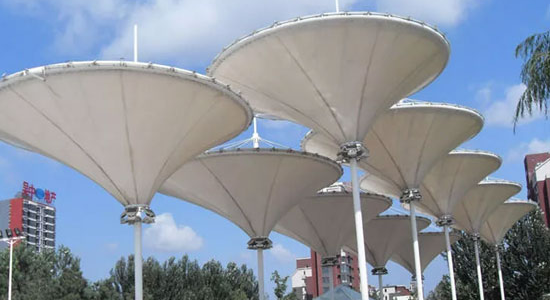In the world of architecture and construction, sustainable design practices are gaining increasing importance as we strive to mitigate the impact of human activities on the environment. Tensile fabric structures have emerged as a versatile and eco-friendly solution, offering a host of environmental benefits that make them an attractive choice for a wide range of projects. Let’s delve into the four key environmental advantages of these innovative structures.
1. Reduced Carbon Footprint
Tensile fabric structures are inherently lightweight compared to traditional building materials such as concrete and steel. This lightweight design translates to lower transportation costs and reduced energy consumption during construction. Additionally, many fabric materials used in tensile structures are recyclable, further minimizing their environmental impact. By requiring fewer resources and generating less waste, tensile fabric structures help reduce carbon emissions and contribute to a more sustainable built environment.
2. Enhanced Energy Efficiency
One of the standout features of tensile fabric structures is their ability to harness natural light while providing shade and protection from the elements. The translucent properties of the fabric allow daylight to penetrate the interior spaces, reducing the need for artificial lighting during the day. This not only decreases energy consumption but also creates a more comfortable and inviting environment for occupants. Furthermore, certain fabric materials used in tensile structures offer excellent thermal performance, helping to regulate indoor temperatures and reduce reliance on mechanical heating and cooling systems. By maximizing natural light and minimizing energy use, tensile fabric structures promote energy efficiency and contribute to lower operational costs.
3. Sustainable Material Choices
The materials used in tensile fabric structures are carefully selected to meet performance requirements while minimizing environmental impact. Many fabric membranes are made from durable, long-lasting materials such as PVC-coated polyester or PTFE-coated fiberglass, which offer excellent resistance to UV radiation, weathering, and environmental degradation. These materials are also recyclable at the end of their lifespan, further reducing waste and promoting resource conservation. Additionally, the modular design of tensile fabric structures allows for easy disassembly and reassembly, facilitating material reuse and extending the lifespan of the structure.
4. Natural Ventilation and Thermal Comfort
Tensile fabric structures can be designed to incorporate natural ventilation systems, allowing for optimal airflow and thermal comfort without the need for mechanical ventilation. The permeable nature of the fabric membranes enables air to circulate freely, creating a pleasant indoor environment even in hot and humid climates. By harnessing natural ventilation, tensile fabric structures reduce the demand for energy-intensive HVAC systems, resulting in lower energy consumption and reduced greenhouse gas emissions.
In conclusion, tensile fabric structures offer a compelling array of environmental benefits, including reduced carbon footprint, enhanced energy efficiency, sustainable material choices, and improved thermal comfort. By incorporating these structures into architectural and construction projects, designers can create sustainable, eco-friendly spaces that promote occupant well-being and minimize environmental impact. As we continue to prioritize sustainability in the built environment, tensile fabric structures stand out as a smart and environmentally responsible choice for the future.

